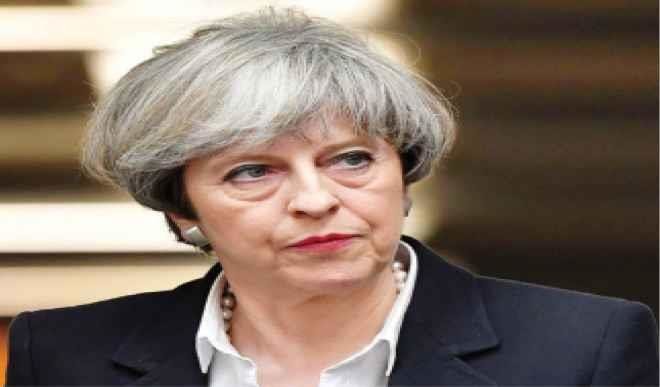If there is a political heaven to which former leaders ascend, for Theresa May it almost certainly resembles a wheat field.
Britain’s second female prime minister once revealed that the “naughtiest” thing she did as a child was to “run through fields of wheat”, to the ire of local farmers.
Her prim admission generated embarrassed giggles – but reveals something about the detached character of this vicar’s daughter raised in Oxfordshire, a persona that became a hallmark of her premiership.
“The word I would use to sum her up is ‘insular,’” said David Jeffery, a lecturer in British politics at the University of Liverpool, who has studied the Conservative Party.
“Her approach has been quite single-minded but also shows a lack of trust in the Conservative Party more broadly, too much trust in her inner circle – and an inability to hear alternative views.”
The key flaw of “the least successful prime minister of the past century”, said Pat Thane, professor in contemporary British history at King’s College London, has been an inability to communicate.
“She doesn’t seem to be good at talking to people – either people with other views in her own party or in other parties, and everybody complains that she is very hard to communicate with – and for a leader that’s very difficult.”
These traits explain why May made a habit of retreating into a form of bunker mentality, enduring a solitary attrition as she doggedly ploughed on with her unpopular plan for the UK’s withdrawal from the European Union.
Oliver Patel, research associate at the University College London European Institute, added: “She does not have a big base of public support, she doesn’t have a big coalition of support within her party or cabinet, she doesn’t really have that many allies or loyalists, and she is not very agile in moving to new positions or policies.”
Brexit blunders
Brexit – the issue by which history will judge May – revealed the strategic shortcomings that such single-mindedness can result in.
Thane said: “She will be remembered for what looks like extraordinary chaos, unparalleled in history.”
Her early mistakes in this process tied her hands in talks with European leaders.
The first was her decision to trigger Article 50 – by which the UK set the clock ticking on its EU departure date – without agreeing on a plan that could command parliamentary support.
A second was setting “red lines” on which she would not budge in her negotiating strategy.
But her belief in her own judgement and reliance on a clique of advisers was evident in her biggest error – calling a snap general election in 2017 in which she squandered an existing Conservative majority and was left leading a minority government.
“All of these issues speak to the same common cause: that she doesn’t trust a lot of people, and by relying on her inner circle instead of talking to Conservative MPs she caused a lot of these problems herself,” said Jeffery.
Apparently lacking a strategy, May approached the deep divisions in her party with a simplistic formula.
Patel said she tried to play off rival Conservative factions by “telling both sides what they want to hear”, an approach exposed by the “cold hard reality” of the Brexit deal she eventually reached with Brussels.
“Strategically it has been shocking – there is one school of thought that she should have picked a side and just run with it to get a majority in parliament, but she tried to please everyone and she has pleased no one.”
Political legacy
May’s most lengthy stint in government was as home secretary from 2010 to 2016 – no mean feat in one of the toughest jobs in politics.
But in characteristic fashion, she turned that portfolio into a bunker, inducing self-imposed siege over the issue of migration.
Thane said: “Her hostile attitude to immigrants has caused continuing problems.”
Migration became such an obsession that May insisted on making freedom of movement a “red line” in her Brexit negotiations.
Yet to many, this siege mentality is curious, because May has also shown an ability to reach out – spearheading the Women2Win campaign to improve Conservative diversity and daring to tell her party that voters regard it as “nasty”.
But that effort went badly wrong just when she needed it most, in an appeal to the public in which she blamed the UK’s precarious Brexit denouement on squabbling MPs – infuriating parliament.
Patel says: “She tried to pull a Donald Trump move but she doesn’t have the Trump base – Trump is incredibly popular with nearly half of the US electorate, but Theresa May doesn’t have a base.”
There is agreement, however, that despite the extraordinary turmoil of the May era, she has not damaged British political institutions.
Patel says: “She has behaved in a way that at times is contemptuous of parliament, she has tried to do things which you could deem unconstitutional – but in a way, you could say that she has strengthened the constitution, because Parliament has managed on many occasions to prevent her. This shows a constitution that is actually working.”
Nonetheless, May has reinforced public disenchantment with politics, insisted Thane.
“British voters have been disrespecting politicians increasingly since the time of Tony Blair, and May has further damaged faith in the system. Popular trust will have to be rebuilt.”
The same might be said for her impact on the Conservative Party, which has been polarising profoundly since May bowed to the inevitable and secured a humiliating extension to the deadline for Britain to leave the EU.
While she is tribally loyal to her party, it has repaid her in quite a different currency, with rebellion and reproach: the disloyal response of many Conservatives to her latest fanciful efforts to champion her doomed Brexit deal for a fourth time was to support Nigel Farage’s new Brexit Party in Thursday’s European elections.
Jeffery believed, however, that history could judge May more kindly.
“In 10 years, when the dust has settled, the story will be that she was driven by a sense of public duty and tried her best – it just wasn’t good enough.”
Source: Al Jazeera News

 Join Daily Trust WhatsApp Community For Quick Access To News and Happenings Around You.
Join Daily Trust WhatsApp Community For Quick Access To News and Happenings Around You.


